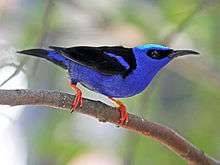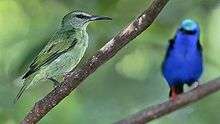Red-legged honeycreeper
| Red-legged honeycreeper | |
|---|---|
 | |
| Adult male | |
| Scientific classification | |
| Kingdom: | Animalia |
| Phylum: | Chordata |
| Class: | Aves |
| Order: | Passeriformes |
| Family: | Thraupidae |
| Genus: | Cyanerpes |
| Species: | C. cyaneus |
| Binomial name | |
| Cyanerpes cyaneus (Linnaeus, 1766) | |
The red-legged honeycreeper (Cyanerpes cyaneus) is a small songbird species in the tanager family (Thraupidae). It is found in the tropical New World from southern Mexico south to Peru, Bolivia and central Brazil, Trinidad and Tobago, and on Cuba, where possibly introduced.
Description

The red-legged honeycreeper is on average 12.2 cm (4.8 in) long, weighs 14 g (0.49 oz) and has a medium-long black, slightly decurved, bill. The male is violet-blue with black wings, tail and back, and bright red legs. The crown of its head is turquoise, and the underwing, visible only in flight, is lemon yellow. After the breeding season, the male moults into an eclipse plumage, mainly greenish with black wings.
Females and immatures are mainly green, with paler, faintly streaked underparts. The legs are red-brown in the female, and brown in young birds.
The call of red-legged honeycreeper is a thin, high-pitched tsip.
Several subspecies are known. Differences are generally slight, with the Tobago race C. c. tobagensis being slightly larger than the mainland forms for example.
The purplish honeycreeper (Chlorophanes purpurascens), a bird from Venezuela known only from the type specimen, is considered to be an intergeneric hybrid between the green honeycreeper and either the red-legged honeycreeper or the blue dacnis.[2]
Ecology
This is a species of forest edge, open woodland, and cocoa and citrus plantations. The red-legged honeycreeper is often found in small groups. It feeds on insects and some fruit[3] and nectar.[4] It responds readily to the (easily imitated) call of the ferruginous pygmy owl (Glaucidium brasilianum).
The female red-legged honeycreeper builds a small cup nest in a tree, and incubates the clutch of two brown-blotched white eggs for 12–13 days, with a further 14 days to fledging.
A specimen studied in the Parque Nacional de La Macarena of Colombia was found to be free of blood parasites.[5]
Common and widespread, the red-legged honeycreeper is not considered a threatened species by the IUCN.[1]
References
- 1 2 BirdLife International (2012). "Cyanerpes cyaneus". IUCN Red List of Threatened Species. Version 2013.2. International Union for Conservation of Nature. Retrieved 26 November 2013.
- ↑ Storer, Robert W. (1957). "The Hybrid Origin of Chlorophanes purpurascens" (PDF). The Auk. 74 (4): 507. doi:10.2307/4081756.
- ↑ e.g. of Trophis racemosa (Moraceae): Foster, Mercedes S. (2007). "The potential of fruit trees to enhance converted habitats for migrating birds in southern Mexico". Bird Conservation International. 17: 45. doi:10.1017/S0959270906000554.
- ↑ e.g. of Dimorphandra sp.: O'Shea, B.J.; Milensky, Christopher M.; Claramunt, Santiago; Schmidt, Brian K.; Gebhard, Christina A.; Schmitt, C. Gregory; Erskine, Kristine T. (2007). "New records for Guyana, with description of the voice of Roraiman Nightjar Caprimulgus whitelyi" (PDF). Bulletin of the British Ornithologists' Club. 127 (2): 118–128.
- ↑ Basto, Natalia; Rodríguez, Oscar A.; Marinkelle, Cornelis J.; Gutierrez, Rafael; Matta, Nubia Estela (2006). "Haematozoa in birds from la Macarena National Natural Park (Colombia)" (PDF). Caldasia. 28 (2): 371–377.
Further reading
- ffrench, Richard; O'Neill, John Patton; Eckelberry, Don R. (1991). A Guide to the Birds of Trinidad and Tobago (2nd ed.). Ithaca, N.Y.: Comstock Publishing. ISBN 0-8014-9792-2.
- Hilty, Steven L. (2003). Birds of Venezuela. Princeton University Press. ISBN 0-7136-6418-5.
External links
| Wikimedia Commons has media related to Cyanerpes cyaneus. |
| Wikispecies has information related to: Cyanerpes cyaneus |
- "Red-legged honeycreeper media". Internet Bird Collection.
- Red-legged honeycreeper Stamps from British Honduras (now Belize), Costa Rica, Nicaragua, Paraguay & Suriname at bird-stamps.org
- Red-legged honeycreeper photo gallery at VIREO (Drexel University)
- Trip Report from birdtours.co.uk featuring a Red-legged honeycreeper photo
- Red-legged honeycreeper species account at NeotropicalBirds (Cornell University)
- Interactive range map of Cyanerpes cyaneus at IUCN Red List maps
- Audio recordings of Red-legged honeycreeper on Xeno-canto.
